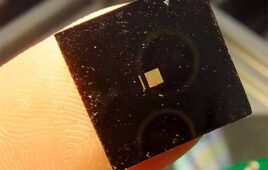
[Image from Northwestern University]
The implantable is a biodegradable wireless device that speeds up nerve regeneration and improves the healing of damaged nerves. The device delivers regular pulses of electricity to damaged peripheral nerves after a surgical repair process to speed up the regrowth of nerves in the legs. The nerve regrowth helps in the recovery process of muscle strength and control.
Materials scientists and engineers at Northwestern University and neurosurgeons at Washington University collaborated to create the device that is the size of a dime and the thickness of a sheet of paper. It is wireless and can operate for about two weeks naturally before it is absorbed into the body.
The researchers suggest that the technology could complement or replace pharmaceutical treatments for a number of medical conditions in humans. They also say that the bioresorbable electronic medicine can offer therapy and treatment over a clinically relevant period of time and directly to a site where it is needed.
“These engineered systems provide active therapeutic function in a programmable, dosed format and then naturally disappear into the body, without a trace,” said Northwestern’s John Rogers, co-senior author of the study, in a press release. “This approach to therapy allows one to think about options that go beyond drugs and chemistry.”
So far, the device has only been tested in rats, but the findings of the study show promise that it can be used as a therapeutic option for nerve injury patients. Until this device, doctors didn’t have a way to continuously administer electrical stimulation during surgery to aid recovery.
“We know that electrical stimulation during surgery helps, but once the surgery is over, the window for intervening is closed,” said co-senior author Dr. Wilson Ray, an associate professor of neurosurgery, biomedical engineering and orthopedic surgery at Washington University. “With this device, we’ve shown that electrical stimulation given on a scheduled basis can further enhance nerve recovery.”
Rogers has been developing electronic materials, device designs and manufacturing techniques for biodegradable devices for eight years. Ray and his Washington University colleagues saw the need for electrical stimulation-based therapies to speed up wound healing. The two teams collaborated and designed the thin, flexible device that wraps around an injured nerve and delivers electrical pulses at certain times during the day. The device is then able to harmlessly degrade in the body, according to the researchers.
The device is powered and controlled wirelessly using a transmitter outside of the body that acts like a cellphone-charging mat. It was tested in rats that had injured sciatic nerves. The sciatic nerve sends signals up and down the legs to control hamstrings and muscles of the lower legs and feet. The researchers delivered electrical stimulation for one hour a day using the device for one, three or six days and no stimulation at all. They monitored recovery for the following 10 weeks.
The researchers found that any electrical stimulation was better than no stimulation to help the rats recover muscle mass and muscle strength. When the rats had more days of electrical stimulation, they were able to more quickly and thoroughly recovery nerve signaling and muscle strength without adverse biological effects.
“Before we did this study, we weren’t sure that longer stimulation would make a difference, and now that we know it does, we can start trying to find the ideal time frame to maximize recovery,” Ray said. “Had we delivered electrical stimulation for 12 days instead of six, would there have been more therapeutic benefit? Maybe. We’re looking into that now.”
The researchers tested a number of compositions and thickness of materials in the device to control the number of days the device can be functional in the body before absorption. Different versions can offer electrical pulses for weeks before degrading. The degrading replaces the need to perform a second surgery to remove a non-degradable electrical stimulation device.
“We engineer the devices to disappear,” Rogers said. “This notion of transient electronic devices has been a topic of deep interest in my group for nearly 10 years — a grand quest in materials science, in a sense. We are excited because we now have the pieces — the materials, the devices, the fabrication approaches, the system-level engineering concepts — to exploit these concepts in ways that could have relevance to grand challenges in human health.”
The researchers suggest that the device could also be used as a temporary pacemaker. The research was published in the journal Nature Medicine.




